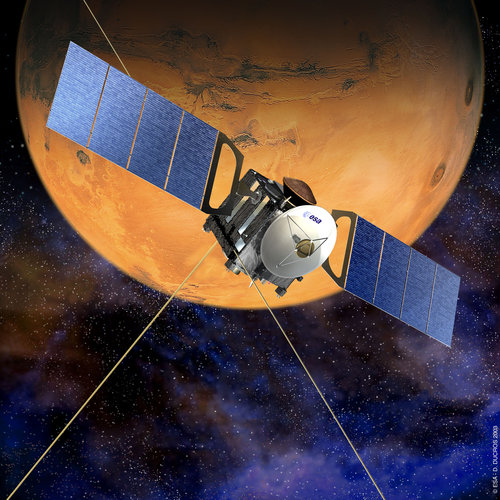
Copernical Team
Simulations ongoing for Biomass launch
 Image:
Simulations ongoing for Biomass launch
Image:
Simulations ongoing for Biomass launch Mission control GO for Biomass launch
 Image:
Mission control GO for Biomass launch
Image:
Mission control GO for Biomass launch Biomass, an oversized football and the Australian outback

ESA’s forest mission Biomass will be supported by a custom-built transponder antenna installed in New Norcia, Australia.
The satellite will fly over the transponder to calibrate its instrument during its six-month commissioning period, and then regularly up to two times a year.
Mars Express updates software, extends lifetime until 2034

Mars Express mission operators at ESOC successfully sent a new software patch that would allow the spacecraft to operate in its third decade.
Europe's largest solid-propellant rocket motors
 Image:
Europe's largest solid-propellant rocket motors
Image:
Europe's largest solid-propellant rocket motors Biomass: from Europe to French Guiana
 Video:
00:02:54
Video:
00:02:54
ESA’s Biomass satellite has been at Europe’s Spaceport in French Guiana since early March, undergoing final preparations for launch aboard a Vega-C rocket. This timelapse video captures key stages of its journey — from its arrival in Kourou to its installation in the launch tower.
Once in orbit, this latest Earth Explorer mission will provide vital insights into the health and dynamics of the world’s forests, revealing how they are changing over time and, critically, enhancing our understanding of their role in the global carbon cycle.
Upcoming ESA–Industry events prepare for Ministerial Council 2025

The European Space Agency (ESA) invites the industrial community to several events where ESA directorates will communicate and coordinate with industry on their proposals and intentions in relation to its Council Meeting at Ministerial Level (CM25) in November.
Vega-C takes Biomass to the sky
 Video:
00:08:17
Video:
00:08:17
ESA’s state-of-the-art Biomass satellite has launched aboard a Vega-C rocket from Europe’s Spaceport in French Guiana. The rocket lifted off on 29 April 2025 at 11:15 CEST (06:15 local time).
In orbit, this latest Earth Explorer mission will provide vital insights into the health and dynamics of the world’s forests, revealing how they are changing over time and, critically, enhancing our understanding of their role in the global carbon cycle. It is the first satellite to carry a fully polarimetric P-band synthetic aperture radar for interferometric imaging. Thanks to the long wavelength of P-band, around 70 cm, the radar signal can
Vega-C liftoff in slow-mo
 Video:
00:05:13
Video:
00:05:13
ESA’s state-of-the-art Biomass satellite launched aboard a Vega-C rocket from Europe’s Spaceport in Kourou, French Guiana. The rocket lifted off on 29 April 2025 at 11:15 CEST (06:15 local time).
In orbit, this latest Earth Explorer mission will provide vital insights into the health and dynamics of the world’s forests, revealing how they are changing over time and, critically, enhancing our understanding of their role in the global carbon cycle. It is the first satellite to carry a fully polarimetric P-band synthetic aperture radar for interferometric imaging. Thanks to the long wavelength of P-band, around 70 cm, the


 Image:
Plato’s dialogue
Image:
Plato’s dialogue